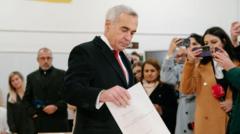The article examines the vulnerabilities in democratic structures by drawing a parallel to the Millennium Footbridge in London, focusing on recent democratic challenges in countries like Hungary and Venezuela.
The Instability of Democracy: Lessons from London's Millennium Footbridge

The Instability of Democracy: Lessons from London's Millennium Footbridge
Analyzing the precarious balance of democratic systems through the lens of engineering failures.
On June 10, 2000, London unveiled the Millennium Footbridge, a striking pedestrian walkway suspended over the River Thames, designed to convey a modern aesthetic. However, shortly after its opening, an unsettling phenomenon emerged: the bridge began to sway uncontrollably as pedestrians traversed it. Engineers determined that the bridge had been engineered for individual movements, but the collective rhythm of a large crowd led to increasing oscillations, ultimately forcing a two-day shutdown for considerable repairs.
This unsettling reality of structural instability brings to mind the fragile state of democracy in various global contexts. Recent explorations into democratic theory have likened democratic systems to suspension bridges, held up by checks and balances akin to suspension cables. When subjected to pressure, even these robust systems can risk teetering off balance, leading to potential collapse.
For instance, Hungary's current political landscape exemplifies one such crisis. A peculiar aspect of the constitution has allowed Prime Minister Viktor Orban to secure a supermajority in parliament. This dominance has granted him the power to amend the constitution freely, enabling him to fortify his position while undermining liberal democratic principles. By manipulating judicial and media institutions, Orban has created a political environment that discourages meaningful electoral competition.
Similarly, Venezuela’s democratic structure suffered a catastrophic blow during Hugo Chávez's presidency. When he sought a referendum to alter the constitution — a decision deemed questionable due to its apparent legal violations — the Supreme Court permitted the process. This enabled Chávez to seize control of Venezuela’s core institutions, allowing him to maintain power for 14 years, a legacy now continued under Nicolás Maduro.
In exploring these instances, we confront a pressing question: how can democracies maintain stability in the face of overwhelming pressure, much like the Millennium Footbridge's design faltering under synchronized movement? The lessons learned from engineering failures provide valuable insights into safeguarding our democratic structures against the forces that threaten their equilibrium.





















